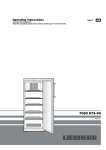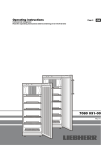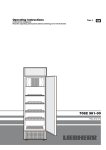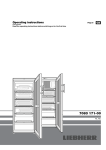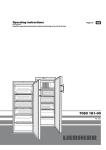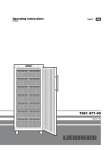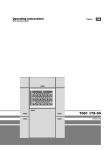Download Liebherr FKvsl 3612 Premium
Transcript
Operating instructions Commercial refrigerator Page 6 GB 7080 031-00 FKv 26 36 41 54 1108 Disposal notes • Keep packaging materials away from children - polythene sheets and bags can cause suffocation! • Please return the packaging to an official collection point. Your old appliance: This contains some reusable materials and should be disposed of properly - not simply with unsorted household refuse. • Discarded appliances should be disabled: Remove the plug, cut through the connection cable and render the catch unusable so that children cannot become trapped inside. • Ensure that the refrigerant circuit is not damaged when the appliance that is no longer needed is taken away for disposal. • Details of the refrigerant can be found on the type plate. • Appliances which are no longer needed must be disposed of in a professional and appropriate way, in accordance with the current local regulations and laws. Range of appliance use The appliance is suited only for cooling food. In the case of commercial food cooling, the pertinent statutory regulations have to be observed. The appliance is not suited for storing and cooling pharmaceuticals, blood plasma, laboratory preparations or similar substances and products subject to the Medical Devices Directive 2007/47/EC. Any misuse of the appliance may result in damage to or spoilage of the stored goods. Furthermore, the appliance is unsuited for use in areas exposed to an explosion hazard. Description of appliance and equipment Temperature control Type plate Safety instructions and warnings • To prevent injury or damage to the unit, the appliance should be unpacked and set up by two people. • In the event that the appliance is damaged on delivery, contact the supplier immediately before connecting to the mains. • To guarantee safe operation, ensure that the appliance is set up and connected as described in these operating instructions. • Disconnect the appliance from the mains if any fault occurs. Pull out the plug, switch off or remove the fuse. • When disconnecting the appliance, pull on the plug, not on the cable. • Any repairs and work on the appliance should only be carried out by the customer service department, as unauthorised work could prove highly dangerous for the user. The same applies to changing the mains power cable. • Do not allow naked flames or ignition sources to enter the appliance. When transporting and cleaning the appliance ensure that the refrigerant circuit is not damaged. In the event of damage, make sure that there are no ignition sources nearby and keep the room well ventilated. • Do not stand on the plinth, drawers or doors or use them to support anything else. • This appliance is not intended for use by persons (including children) with reduced physical, sensory or mental capabilities or lack of experience and knowledge unless they have been given initial supervision or instruction concerning use of the appliance by a person responsible for their safety. Children should be supervised to ensure that they do not play with the appliance. • Avoid prolonged skin contact with cold surfaces or chilled/frozen food. This could cause pain, numbness and frostbite. In the case of prolonged skin contact, protective measures should be taken, e.g. gloves should be worn. • Do not consume food which has been stored for too long, as it could cause food poisoning. • Do not store explosives or sprays using combustible propellants such as butane, propane, pentane etc. in the appliance. Electrical components might cause leaking gas to ignite. You may identify such sprays by the printed contents or a flame symbol. • Do not use electrical appliances inside the appliance. • If you have a lockable appliance, do not keep the key near the appliance or within reach of children. Climate rating The appliance is set to operate within specific ambient temperature limits according to its climate rating.These temperature limits should not be exceeded. The correct climate rating for your appliance is indicated on the type plate. Climate rating SN N ST T Grid shelves Adjustable height feet 6 Ambient temperature +10°C to +32°C +16°C to +32°C +16°C to +38°C +16°C to +43°C Setting up • Avoid positioning the appliance in direct sunlight or near cookers, radiators and similar sources of heat. • The floor on which the appliance stands should be horizontal and level.Compensate for uneven floors with the adjustable feet. • Always ensure that there is good ventilation and that the outward flowing air is able to escape. • Standard EN 378 specifies that the room in which you install your appliance must have a volume of 1 m3 per 8 g of R 600a refrigerant used in the appliance, so as to avoid the formation of inflammable gas/air mixtures in the room where the appliance is located in the event of a leak in the refrigerant circuit. The quantity of refrigerant used in your appliance is indicated on the type plate on the inside of the appliance. • Do not connect the appliance to the supply with other equipment using an extension cable - risk of overheating. Dimensions Height FKv 26 ............................. 1250 FKv 36 ............................. 1640 FKv 41 ............................. 1800 FKv 54 ............................. 1640 Width 600 600 600 750 Depth 610 610 610 730 Connecting to the mains Power supply (a.c.) and voltage at the operating point must comply with the details on the type plate. The socket must be fused with a 10 A fuse or higher, it must be away from the rear of the appliance and must be easily accessible. Connect the appliance with a properly earthed fused plug and socket only. The wires in the mains lead are coloured in accordance with the following code: green/yellow = earth, blue = neutral, brown = live. Warning! This appliance must be earthed. Switching the appliance on and off You are recommended to clean the appliance before switching it on for the first time (see Cleaning). To switch the appliance on: Connect the appliance to the mains - the appliance is switched on. To switch the appliance off: Pull out the mains plug or set the temperature control to 0. Setting the temperature Using a coin, turn the arrow on the temperature control to a setting between 0 und max. The nearer the temperature control is to the max. setting, the colder the interior temperature. Cooling This appliance can be used for chilling all types of drinks and food. Interior light in appliances with glass door GB The interior light is fitted on the inside at the top. It can be switched on and off by pressing the switch Light. To change the tube: Pull out the mains plug or remove/unscrew the fuse. • Undo the screw on the back of the light cover. • Push buttons T on the back of the cover. • Detach the cover at the back and remove. • Change the fluorescent tube. • Insert the cover at the front and click into place at the back. • Screw the screw into the cover. Temperature display The thermometer is located in the upper part of the door. The temperature display is powered by a battery which is available from your specialist dealer. Changing the battery • Open the door. • Detach cover A. • Pull out thermometer T. • Open the battery compartment using a small screwdriver. • Replace the battery. • Close the battery compartment. • Re-install all parts. If Er or HH appears in the display, the appliance has a fault. Consult the customer service department indicating the fault number displayed. Safety lock The lock in the appliance door is equipped with a safety mechanism. Locking the appliance: • Insert the key as shown by arrow 1. • Turn the key 90° anticlockwise. To unlock the appliance, the same procedure must be repeated in the same order. Turn the key clockwise. The grid shelves can be moved to accommodate different height bottles or packages.To remove the shelves the door must be opened wider than 90°. High-percentage alcohols should be tightly sealed and stored upright. The ventilation slots on the inside must not be covered! 7 Defrosting The refrigerator compartment defrosts automatically. When operating at the coldest thermostat setting, the interior rear wall may, however, ice up. In this case, the appliance must be defrosted manually. • Switch the appliance off to defrost. Pull out the mains plug or set the temperature control to 0. • Remove the food from the appliance and store in a cool place. • Leave the door of the appliance open while defrosting. After defrosting mop up the remaining water and clean the appliance. Do not use any mechanical devices or other artificial aids for defrosting other than those recommended by the manufacturer. Cleaning Before cleaning always switch off the appliance. Pull out the mains plug or remove/unscrew the fuse. Clean the inside, equipment parts and outer walls with lukewarm water and a little detergent. Do not use abrasive or acid cleaners or chemical solvents. Do not use steam cleaners because of the risk of injury and damage. • Ensure that no cleaning water penetrates into the electrical components or ventilation grille. • The dust should be removed from the refrigeration unit and heat exchanger - metal grid at the back of the appliance - once a year. • Clean the drain hole in the refrigerator compartment with a thin object, e.g. cotton swab or the like. • Do not damage or remove the type plate on the inside of the appliance. It is very important for servicing purposes. Malfunctions You may be able to rectify the following faults by checking the possible causes yourself: • Appliance does not function: – Is the appliance switched on? – Is the plug correctly fitted in the mains socket? – Is the socket fuse intact? • Loud running noise: – Is the appliance set up firmly on the floor? – Does the appliance cause nearby items of furniture or objects to vibrate? Please note that noises caused by the refrigerant circuit cannot be avoided. • The temperature is not low enough: – Is the temperature setting correct (see Setting the temperature)? – Have excessive amounts of fresh food been placed in the appliance? – Does the separately installed thermometer show the correct reading? – Is the ventilation system working properly? – Is the appliance set up too close to a heat source? If none of the above causes apply and you cannot rectify the fault yourself, contact the nearest customer service department stating the type of appliance ➊, service number ➋ and appliance number ➌ as indicated on the type plate. The type plate is located in the refrigerator compartment on the left-hand side. Shutting your appliance down If your appliance is to be shut down for any length of time, switch it off and disconnect the plug or remove the fuse. Clean the appliance and leave the door open in order to prevent unpleasant smells. The appliance complies with the relevant safety regulations and EC directives 2004/108/EC and 2006/95/EC. 8 GB Changing over door hinges 1. Pull out the circlip from the lower hinge bracket. 2. Remove cover plate. 3. Unscrew the hinge pin from the upper hinge bracket. 4. Remove the door. 9. Transfer handle and plugs to the opposite side of the door. 10. Pull out the torque rod from the right-hand door mounting. The bar is approx. 1130 mm long. 11. Turn the torque rod through 180° horizontally and insert into the left-hand door mounting. 5. Transfer clamping plate. 12. Place the door on the lower hinge bracket. 6. Transfer hinge components and cover plates to the opposite side. 13. Screw in the hinge pin. 14. Align the door at the side and tighten the hinge pin. 15. Replace cover plate. 7. Transfer lower hinge bracket and cover plate to the opposite side. 16. Tighten the torque rod with the open-ended spanner provided. > 60° The hexagon of the torque rod will lock into the lower hinge bracket. 8. Transfer lock and cover plates to the opposite side of the door. 17. Fit the circlip on the lower hinge bracket. 9






